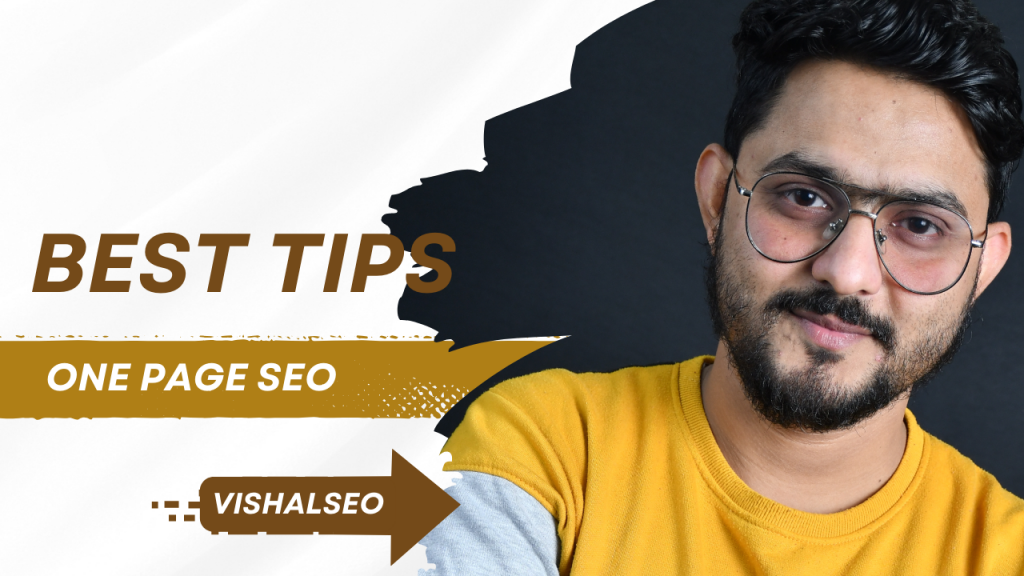Best On Page SEO Tips | Step By Step Guide
In the ever-evolving landscape of digital marketing, on page SEO tips remains a cornerstone for improving search engine rankings and driving organic traffic to your website. On-page SEO refers to the practice of optimizing individual web pages to rank higher and earn more relevant traffic in search engines. This involves both the content and HTML source code of a page. Here, we delve into the best on-page SEO tips to help your website stand out in search engine results pages (SERPs).
Want to learn SEO in Meerut ?

1. Title Tags and Meta Descriptions | One of the Best On Page SEO Tips .
Crafting Compelling Title Tags
The title tag is one of the most critical elements of on-page SEO. It tells both users and search engines what the content of the page is about. A well-crafted title tag should be:
- Relevant: Accurately describe the content.
- Concise: Between 50-60 characters.
- Keyword-Rich: Include primary keywords, but avoid keyword stuffing.
For example, instead of a generic title like “Blog Post,” use something specific like “10 Best On-Page SEO Tips for 2024.”
Optimizing Meta Descriptions
Meta descriptions, while not a direct ranking factor, play a significant role in click-through rates (CTR). A good meta description should:
- Be Persuasive: Encourage clicks by being compelling and relevant.
- Include Keywords: Naturally incorporate primary and secondary keywords.
- Be Concise: Keep it within 150-160 characters.
Example: “Discover the top 10 on-page SEO tips to boost your website’s ranking and drive more traffic. Learn the latest strategies for 2024.”
2. Quality Content ( Best on Page SEO Tips )
Creating Valuable Content
Content is king in SEO. Search engines prioritize pages that provide valuable, relevant, and well-researched information. To ensure your content stands out:
- Focus on E-A-T: Expertise, Authoritativeness, and Trustworthiness.
- Address User Intent: Understand what your audience is searching for and deliver content that meets their needs.
- Update Regularly: Keep content fresh and up-to-date.
Using Keywords Effectively
Keywords remain crucial, but their role has evolved. Instead of keyword stuffing, focus on:
- Primary Keywords: Main keywords around which your content is centered.
- Secondary Keywords: Related terms and synonyms that provide context.
- LSI Keywords: Latent Semantic Indexing keywords that help search engines understand the content.
3. Header Tags
Structuring Content with Headers
Header tags (H1, H2, H3, etc.) play a critical role in structuring your content, making it easier for users and search engines to understand. Here’s how to use them effectively:
- H1 Tag: Use for the main title of the page. It should be unique and descriptive.
- H2 Tags: Use for main subheadings, which break down the content into digestible sections.
- H3 Tags and Beyond: Use for additional subsections under H2 headings.
For example, in this article, “Best On-Page SEO Tips” is the H1, while “Title Tags and Meta Descriptions” and other subheadings are H2 tags.
4. URL Structure
Crafting SEO-Friendly URLs
A clean and descriptive URL structure is vital for both SEO and user experience. Best practices for URLs include:
- Short and Descriptive: Keep URLs concise and descriptive of the content.
- Use Keywords: Incorporate primary keywords naturally.
- Avoid Special Characters: Use hyphens to separate words and avoid underscores and special characters.
Example: Instead of using –
5. Internal Linking
Enhancing Navigation and SEO
Internal linking helps search engines understand the structure of your website and distribute page authority. Effective internal linking involves:
- Linking Relevant Content: Connect related pages to improve user experience.
- Using Descriptive Anchor Text: Use keywords in anchor text that describe the linked page’s content.
- Balancing Links: Ensure a natural flow without overloading pages with too many links.
Example: Linking to related articles like “Top Off-Page SEO Strategies” within this content can enhance relevance and authority.
Example. –
6. Image Optimization
Optimizing Images for SEO
Images enhance user experience and can drive traffic through image searches. Optimize images by:
- Using Descriptive File Names: Name images with relevant keywords before uploading.
- Adding Alt Text: Provide descriptive alt text that includes primary keywords.
- Compressing Images: Reduce file size to improve page load speed.
Example: Instead of “IMG001.jpg,” use “on-page-seo-tips.jpg” as a file name.
7. Mobile-Friendliness
Ensuring Mobile Optimization
With mobile traffic surpassing desktop, having a mobile-friendly website is essential. Google’s mobile-first indexing prioritizes mobile versions of websites. Key mobile optimization tips include:
- Responsive Design: Ensure your site adapts to different screen sizes.
- Fast Loading Speed: Optimize images and use efficient coding to reduce load times.
- User Experience: Simplify navigation and improve readability on smaller screens.
8. Page Speed
Enhancing Page Load Speed
Page speed is a crucial ranking factor. Faster pages lead to better user experience and higher rankings. Improve page speed by:
You can test your website speed at GT Metrix
- Minimizing HTTP Requests: Reduce the number of elements on a page.
- Using Browser Caching: Store static files to speed up load times for returning visitors.
- Optimizing Code: Minify CSS, JavaScript, and HTML.
9. Schema Markup
Implementing Structured Data
Schema markup helps search engines understand your content better and can enhance SERP features like rich snippets. Benefits of schema markup include:
- Improved Visibility: Enhance your appearance in search results.
- Better CTR: Rich snippets can improve click-through rates.
Types of schema markup include:
- Article: For blog posts and news articles.
- Product: For e-commerce product pages.
- Review: For customer reviews and ratings.
10. User Engagement Metrics
Focusing on User Experience
Search engines consider user engagement metrics, such as bounce rate, dwell time, and click-through rate, when ranking pages. Improve these metrics by:
- Providing Quality Content: Engage visitors with valuable information.
- Improving Readability: Use short paragraphs, bullet points, and images.
- Encouraging Interaction: Add comment sections, social sharing buttons, and calls to action.
Conclusion
On-page SEO is a dynamic field requiring continuous adaptation to search engine algorithms and user behavior. By implementing these best practices, you can enhance your website’s visibility, drive more organic traffic, and provide a better user experience. Remember, successful SEO is about providing value to users and ensuring your content is easily accessible and understandable to search engines.
